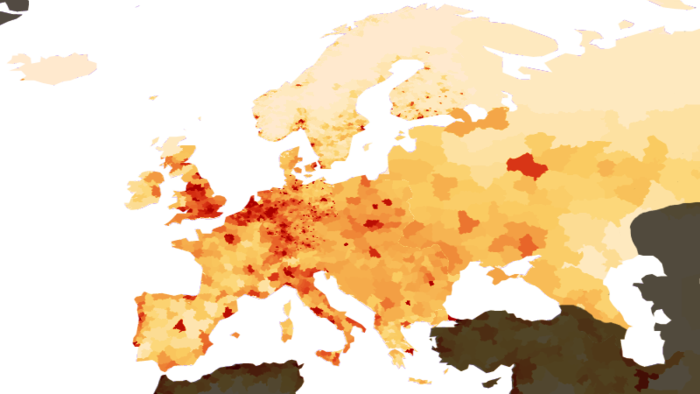
India is the most populous country in the world with one-sixth of the world's population. According to UN estimates, India overtook China in having the largest population in the world with a population of 1,425,775,850 at the end of April 2023.

Ireland had an estimated population of 5,281,600 as of 1 April 2023.
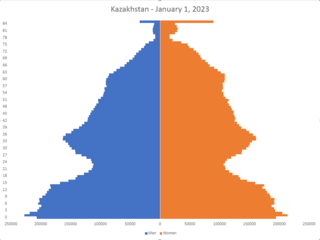
The demographics of Kazakhstan enumerate the demographic features of the population of Kazakhstan, including population growth, population density, ethnicity, education level, health, economic status, religious affiliations, and other aspects of the population. Some use the word Kazakh to refer to the Kazakh ethnic group and language and Kazakhstani to refer to Kazakhstan and its citizens regardless of ethnicity, but it is common to use Kazakh in both senses. It is expected that by 2050, the population will range from 23.5 to 27.7 million people.

Laos is a country in Southeast Asia. The country's population was estimated at about 7.43 million in 2021, dispersed unevenly across the country. Most people live in valleys of the Mekong River and its tributaries. Vientiane Prefecture, which includes Vientiane, the capital and largest city of the country, had 820,924 residents as of the 2015 census. The country's population density is 26.7/km2.
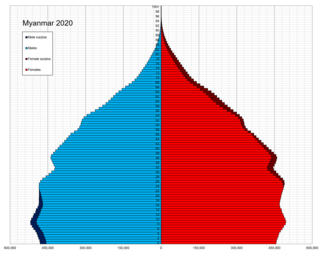
This is a demography of Myanmar including statistics such as population, ethnicity, language, education level, and religious affiliations.

As of the 2021 census, the population of Russia was 147.2 million. It is the most populous country in Europe, and the ninth-most populous country in the world, with a population density of 8.5 inhabitants per square kilometre. As of 2020, the overall life expectancy in Russia at birth was 71.54 years.

Demographic features of the population of Turkey include population density, ethnicity, education level, health of the populace, economic status, religious affiliations and other aspects of the population.
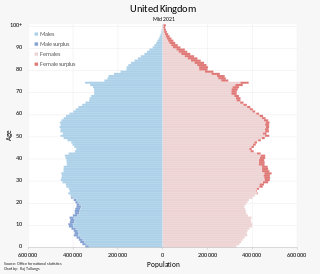
The population of the United Kingdom was estimated at over 67.0 million in 2020. It is the 21st most populated country in the world and has a population density of 270 people per square kilometre, with England having significantly greater density than Wales, Scotland, and Northern Ireland. Almost a third of the population lives in south east England, which is predominantly urban and suburban, with about 9 million in the capital city, London, whose population density is just over 5,200 per square kilometre.

According to the United Nations, Ukraine has a population of 36,744,636 as of 2023. In July 2023, Reuters reported that due to the refugee outpouring into Western Europe, the population of Kyiv-controlled areas may have decreased to as low as 28 million. This is a steep decline from 2020, when it had a population of almost 42 million people. This is in large part due to the ongoing Ukrainian refugee crisis and loss of territory caused by Russia's invasion of Ukraine. The most recent census of a post-Soviet Ukraine occurred over 20 years ago, in 2001. Thus, much of the information presented here could be inaccurate and/or outdated.

Demographic features of the population of Uzbekistan include population growth, population density, ethnicity, education level, health, economic status, religious affiliations, and other aspects of the population. The nationality of a person from Uzbekistan is Uzbekistani, while the ethnic Uzbek majority call themselves Uzbeks. Much of the data is estimated because the last census was carried out in Soviet times in 1989.

Iran's population increased dramatically during the later half of the 20th century, reaching about 80 million by 2016. As of 2022, Iran's population is around 86.5 million. In recent years, however, Iran's birth rate has dropped significantly. Studies project that Iran's rate of population growth will continue to slow until it stabilises above 100 million by 2050. Half of Iran's population was under 35 years old in 2012.

The demography of France is monitored by the Institut national d'études démographiques (INED) and the Institut national de la statistique et des études économiques (INSEE). As of 1 January 2021, 65,250,000 people lived in Metropolitan France, while 2,785,000 lived in overseas France, for a total of 68,035,000 inhabitants in the French Republic.

Demographic features of the population of the Czech Republic include population density, ethnicity, education level, health of the populace, economic status, and religious affiliations.

According to data from the 1989 Soviet census, the population of the USSR was made up of 70% East Slavs, 17% Turkic peoples, with no other single ethnic group making up more than 2%. Alongside the atheist majority of 60%, there were sizable minorities of Russian Orthodox Christians and Muslims.

Christianity is the largest religion in Belgium, with the Catholic Church representing the largest community, though it has experienced a significant decline since the 1950s. Belgium's policy separates the state from the churches, and freedom of religion of the citizens is guaranteed by the country's constitution.

Religion has been a major influence on the societies, cultures, traditions, philosophies, artistic expressions and laws within present-day Europe. The largest religion in Europe is Christianity. However, irreligion and practical secularisation are also prominent in some countries. In Southeastern Europe, three countries have Muslim majorities, with Christianity being the second-largest religion in those countries. Ancient European religions included veneration for deities such as Zeus. Modern revival movements of these religions include Heathenism, Rodnovery, Romuva, Druidry, Wicca, and others. Smaller religions include Indian religions, Judaism, and some East Asian religions, which are found in their largest groups in Britain, France, and Kalmykia.

Religion in the European Union is diverse. The largest religion in the EU is Christianity, which accounted for 72.8% of EU population as of 2018. Smaller groups include those of Islam, Buddhism, Judaism, Hinduism, and some East Asian religions, most concentrated in Germany and France. Also present are revival movements of pre-Christianity European folk religions including Heathenism, Rodnovery, Romuva, and Druidry.
Europeans are the focus of European ethnology, the field of anthropology related to the various ethnic groups that reside in the states of Europe. Groups may be defined by common genetic ancestry, common language, or both.
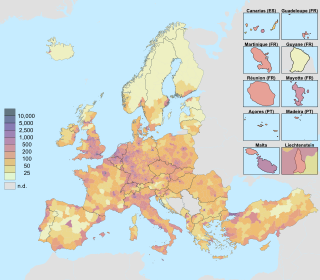
The demographics of the European Union show a highly populated, culturally diverse union of 27 member states. As of 1 January 2023, the population of the EU is around 448 million people.
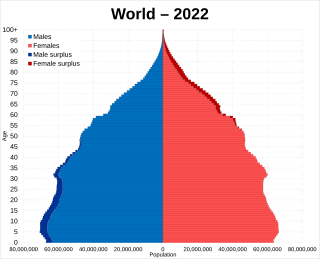
Earth has a human population of over 8 billion as of 2024, with an overall population density of 50 people per km2. Nearly 60% of the world's population lives in Asia, with almost 2.8 billion in the countries of China and India combined. The percentage shares of China, India and rest of South Asia of the world population have remained at similar levels for the last few thousand years of recorded history. The world's literacy rate has increased dramatically in the last 40 years, from 66.7% in 1979 to 86.3% today. Lower literacy levels are mostly attributable to poverty. Lower literacy rates are found mostly in South Asia and Sub-Saharan Africa.
























































